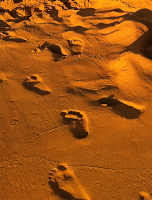Cheryl Snell's Blog, page 43
February 9, 2011
Escape into Life
A nice spread on my sister Janet here.Great venue, too.
Published on February 09, 2011 01:01
February 8, 2011
for the little ones
Faces of the Gods from Chani Petro on Vimeo.
Published on February 08, 2011 10:41
February 7, 2011
Saraswathi Shloka
Tomorrow, in North india especially, the celebration of spring, Basant Panchami,is observed. An important feature is the Saraswati puja, when the goddess of learning is worshiped.
Books and musical instruments are placed on a wooden plank covered in red silk—-perhaps the family ledger, one of the children's math books, copies of the Ramayana or Bhagavad Gita. Sometimes a tool or small machine is added.
Sanskrit slokas like this one are recited:
"Shrii Saraswatii Namahstubhyam Varade Kaama Ruupini/Twaam Aham Praarthane Devii Vidyaadaanam Cha Dehi Me" (I bow to Goddess Saraswati, who fulfills the wishes of the devotees. I pray her to enlighten me with knowledge.) It is believed that the Goddess herself is blessing the books and the instruments.
On this day, Vidyarambham, Hindu children are taught to write their first word. It's an auspicious day to begin a child's education.Initiation into the world of alphabets usually begins with the writing of the mantra Om hari sri ganapataye namah" Hari refers to the Lord, sri to prosperity.
"When you were five, I remember your father helping you to form the sacred letter Shri on your first Saraswati puja. We had chosen the books for the altar and I added a harmonium. The Goddess of Learning loves music! Your aunties and I wore yellow saris and made coconut koyakattai. I was so proud when you were old enough to read at the altar beside your father. But very soon, you would whisper to him, as if the Goddess might overhear, "Is that enough, Appa?" It was the same way Ram always asked Samba." (from Shiva's Arms)
The mantra is written first on sand, denoting practice; then in a tray of rice grains, representing the acquisition of knowledge, which leads to prosperity. Finally, the priest writes the mantra on the child's tongue with gold, symbolic of the wealth of true knowledge. The women in the family wear yellow saris, decorate with palash flowers or marigolds, and distribute coconut koyakkatai as prasad for the worshipers.
Published on February 07, 2011 09:20
Progress in Red Room
Red Room picked my video, Progress, recently published in Soundzine, as Best Video in their Best of Red Room feature on the homepage. Huzzahs!
Published on February 07, 2011 06:45
February 6, 2011
One Stop Poetry

The photograph prompt at One Stop Poetry today is by Sean McCormick. I think it lends itself wonderfully to words. Care to join in?
Threshold
Leaning on cut-out sky, the warped window
twists like an arthritic hip. Better off untouched,
we decide, and leave it embedded in decades of dirt.
That house once had good bones; made it hard
to move. We imagined French doors thrown open
on guests lined up to the horizon, shimmering in fancy dress
at the seam of earth and sky.
Such dreaming exhausted us. To steady
our nerves, we plucked at the piano's guts,
summoned singalongs already gone sharp or flat.
Silence curdled light slumped against sun-bleached walls.
We'd never have chosen that color
if we'd known how it would fade,
or that we'd have to live with it so long.
Published on February 06, 2011 08:13
February 5, 2011
Dream House
This is a hard copy of the e-book on Scribd I was just telling you about. Help yourself!
Published on February 05, 2011 08:29
February 3, 2011
Scribd
Thanks to Scribd, for featuring my e-book of poems,Dream House. The collection is free for download and I'd love to hear what you think.
Published on February 03, 2011 14:22
February 1, 2011
Soundzine
Published on February 01, 2011 20:06
January 31, 2011
Composing a Poem
My ninety year old mother broke her hip last spring. She is a modest woman, but one day she wanted to show me her scar. Why would she do that? And how could I describe it? How much history should I include - for instance, should I let the reader know she has Alzheimer's? I decided to open with the moment itself:
I'm taking everything off/ she announces, clawing at her clothes/
The verbs point to her loosened inhibitions and the quality of her thinking. This is no stripper. There is no playfulness in her act.
Moving to a description (a new scar gleams on her mended hip) that is stark and unsparing, the poem finds its identity in this line:
Where did this come from, where is it going?
I needed to make clear the loss of memory here, the shock that recurs each time a patient is confronted with what she has already grieved over.
The reader's attention now focuses on the scar, described with the brusque-sounding "cross-hatched" and its location on the ruins of the body.
A cross-hatched seam
in the center of a body's landslide.
A cradle for children, a long-ago man; a broken wing.
The reader follows as the old woman touches her scar like a blind person, and when the raised pattern of the scar is likened to "A railroad crossing pocked with stop-signs./A fire escape going down.// the poem demands the reader not flinch from the images of exit.
Ninety
I'm taking everything off
she announces, clawing at her clothes.
A new scar gleams on her mended hip.
Where did this come from, where is it going?
A cross-hatched seam
in the center of a body's landslide.
A cradle for children, a long-ago man; a broken wing.
She begins brailing her fingertip down
the red raised tracks. It's not what she expected.
A railroad crossing pocked with stopsigns.
A fire escape going down.
I'm taking everything off/ she announces, clawing at her clothes/
The verbs point to her loosened inhibitions and the quality of her thinking. This is no stripper. There is no playfulness in her act.
Moving to a description (a new scar gleams on her mended hip) that is stark and unsparing, the poem finds its identity in this line:
Where did this come from, where is it going?
I needed to make clear the loss of memory here, the shock that recurs each time a patient is confronted with what she has already grieved over.
The reader's attention now focuses on the scar, described with the brusque-sounding "cross-hatched" and its location on the ruins of the body.
A cross-hatched seam
in the center of a body's landslide.
A cradle for children, a long-ago man; a broken wing.
The reader follows as the old woman touches her scar like a blind person, and when the raised pattern of the scar is likened to "A railroad crossing pocked with stop-signs./A fire escape going down.// the poem demands the reader not flinch from the images of exit.
Ninety
I'm taking everything off
she announces, clawing at her clothes.
A new scar gleams on her mended hip.
Where did this come from, where is it going?
A cross-hatched seam
in the center of a body's landslide.
A cradle for children, a long-ago man; a broken wing.
She begins brailing her fingertip down
the red raised tracks. It's not what she expected.
A railroad crossing pocked with stopsigns.
A fire escape going down.
Published on January 31, 2011 13:07
January 30, 2011
One Stop Poetry

Featured at One Stop Poetry is an interview with photographer Iquanyin Moon and the picture prompt above.
This poem is in response to the picture. Visit One Stop Poetry to join in!
Absolution
Summer hummed with machines—
muscle cars flashing toothy chrome
burned rubber as boom-boxed music
shook the block. We swayed
to the beat, invincible under our tans.
One night, we staggered toward the river
to absolve our ringing ears, arms filled
with seashells, ridged, shucked absences
that would prove it had been no dream
when the drowning began. Loss flowed
into me like light. I opened my mouth
to an alibi of dark and exhaled stars.
Surf pulled from the shore; we disappeared.
Along the horizon, heads turned away,
interest already lost in the shells that arrived
with our leaving, though the trail reached back
far as a reckoning, in a line
long enough for light to follow.
Published on January 30, 2011 12:04



